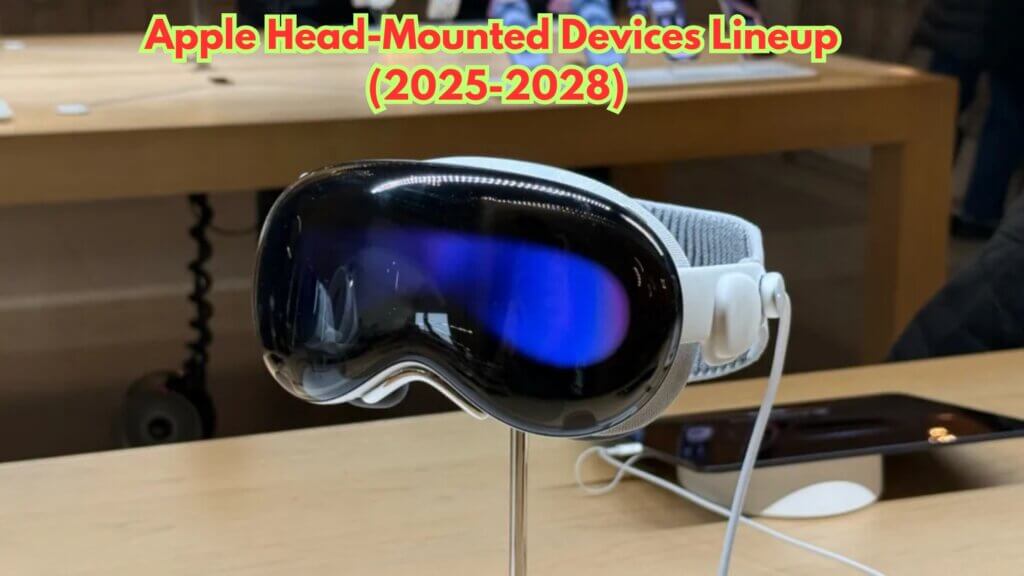#Apple Vision Pro, #Vision Air, #Vision Pro 2, #Apple Head-Mounted Devices, #Vision Pro M5, #Smart Glasses, #XR Glasses.

What could the next major revolution in consumer tech look like? Apple appears to be answering with a bold vision for its head-mounted devices. From extended reality (XR) to stylish smart glasses, Apple is gearing up for a future where wearable tech alters the way we interact with the digital world. But how far along is Apple on this roadmap, and what should we expect from its innovative Apple head-mounted devices?
As per Ming-Chi Kuo, a Supply chain analyst. This article explores the current state and future potential of Apple’s head-mounted devices, their roadmap, and the opportunities and challenges facing Apple as it navigates this uncharted territory in the realm of Apple head-mounted devices.
Read More: How Apple Plans to Reimagine the Vision Pro into a Multiproduct Tech Empire?
Where Apple Stands Today: Apple Vision Pro M5
Apple’s presence in head-mounted technologies began with the Vision Pro, introduced as the ultimate XR headset. Now, Apple is moving forward with the Vision Pro M5 Version, slated for mass production in Q3 2025 with annual shipments projected at 150,000–200,000 units. The upgrades are focused on implementing an M5 chip with unchanged core specifications.
Why the Vision Pro Matters?
As we look toward the future, the potential of Apple head-mounted devices to redefine user experiences cannot be overstated.
- Market Presence Maintenance: By building on its Vision Pro line, Apple is cementing its position as a premier player in the XR landscape.
- Ecosystem Development: These devices serve as platforms to grow Apple’s ecosystem of XR applications.
- Problem Solving through Innovation: The Vision Pro isn’t just about AR or VR. It’s about creating seamless experiences from inventory management tools to immersive communications for businesses.
But with a hefty price tag and limited utility for casual users, the Vision Pro remains a niche product. This sets the stage for Apple’s plans to roll out a broader, more accessible lineup in the coming years.
Apple’s Head-Mounted Future Roadmap
Apple’s upcoming devices are designed for wider adoption rates. Here’s what their roadmap looks like:
1. Vision Air (Coming in 2027)
Among Apple’s most innovative upcoming products, the Vision Air reaches for broader consumer appeal by offering a redesigned, lightweight form factor with a 40% reduction in weight compared to the Vision Pro. It will use Apple’s flagship iPhone processors to keep costs sustainable, making it substantially more affordable.
Key highlights:
- Weight Reduction: Achieved by swapping glass panels for lighter plastic and using magnesium alloys.
- Target Market: A Wider base of consumers seeking XR integration at a lower price.
2. Vision Pro 2nd Generation (Expected in Q2 2028)
An evolved model of the Vision Pro, it’s set to integrate a Mac-grade processor while focusing on further weight and price cuts, aimed at ensuring mass-market adoption.
3. Ray-Ban-Like Smart Glasses (Anticipated in Q2 2027)
Imagine Apple’s take on stylish, wearable tech. Although they lack display functionality, these smart glasses offer features such as audio playback, environmental AI sensing, gesture recognition, and video capture, representing Apple’s biggest step toward mass adoption. Shipment predictions of 3–5 million units for the first year alone suggest significant potential as an on-the-go utility device replacing some TWS functions.
- No Screens Needed: Unlike other smart glasses, Apple’s debut model focuses on practicality without a display.
- Style Matters: Expect modern designs for real-world usability.
4. XR Glasses (Coming in Q2 2028)
Expand utility, and elevate experience. With LCoS waveguide-based colour displays and advanced AI-powered operational functions, Apple’s XR glasses push hardware horizons. Built to showcase display-based experiences, these glasses cater to both casual users and businesses.
Challenges on the Horizon
Apple’s ambitious roadmap is exciting, but challenges abound. Here are the critical hurdles:
Technical Challenges
- Hardware Limitations: Lightweight designs are hard to balance with the need for high-performing processors and batteries.
- Display Technology: Perfecting waveguides and lenses while keeping costs manageable is no small feat.
AI Ecosystem Integration
- Apple’s success hinges on integrating AI into a specialised ecosystem for its devices. Without robust software and OS capabilities, hardware innovation alone won’t ensure utility or user adoption.
Market Dynamics
- Competition: Apple won’t be alone. Industry players like Meta and Google are expected to preempt Apple in this field with competitive offerings.
- High Costs Of XR apps and hardware imply carrying forward the challenge of initially limited adoption post-marketing funnel for days.
Why Apple Could Still Lead?
1. Unmatched Hardware Expertise
Apple’s unparalleled ability to create premium hardware gives it a competitive edge. The build quality and engineering of Apple devices consistently set market benchmarks. For example, achieving a 40% weight reduction for Vision Air showcases Apple’s industry-leading design.
2. Ecosystem Interconnectivity
From seamless integration with iPhones to tailoring apps for XR hardware, Apple’s ecosystem ensures a level of convenience others can hardly match.
3. Brand Heritage
Apple’s reputation alone will attract both consumers and developers, driving software adoption and providing monetisation opportunities that early competitors struggle to realise.
What Comes Next?
The evolution of head-mounted devices could redefine consumer and enterprise technology. Apple’s roadmap reflects a calculated approach to entering this dynamic space. Whether it’s about creating better business tools or fashionable eyewear capable of transforming how we connect with the world, Apple appears to be keeping its cards close to its chest—but betting big.
FAQ: Apple Head-Mounted Devices
Is Apple Vision Pro 2 coming out?
Yes, as per the rumours, it will launch in Q2 2028.
Is Apple suspending Vision Pro 2?
No, but initially Apple will launch Vision Air version headset and then in 2028 we can expect the launch of Vision Pro 2.
How much does the Apple Vision Pro 2 cost?
It will be cheaper than Apple Vision Pro; the price should be around $1500 – $2000.
Is Apple Vision Pro discontinued?
No, Apple is working on a lighter version of Vision Air and 2nd generation version of Vision Pro.
